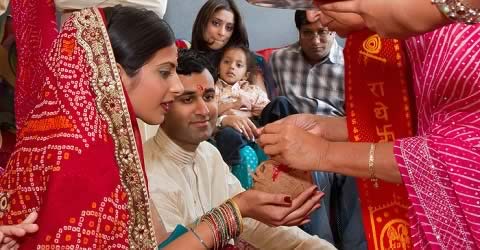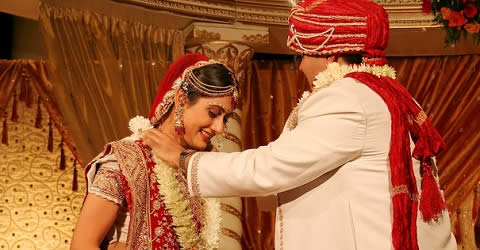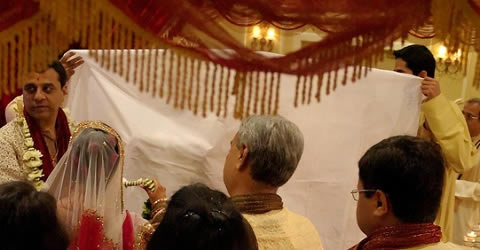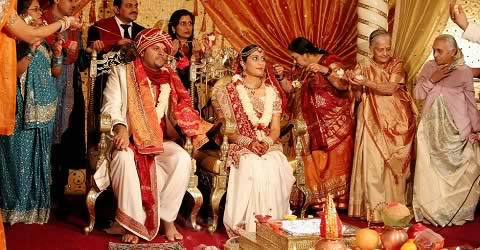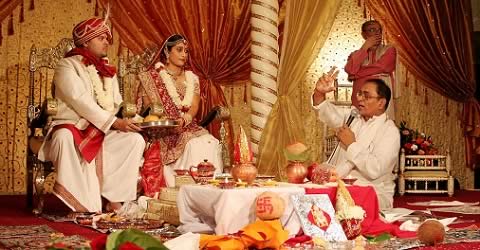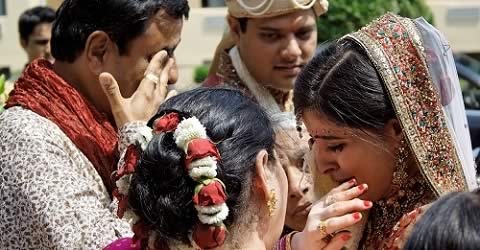The rituals, ceremonies and customs in a Hindu Gujarati Wedding (“Lagan” or “Vivaaha“) are listed below.
Hindu Gujarati Wedding: Pre-Wedding Ceremonies
1] “Chandlo Matli” – Acceptance of the Marriage
This Gujarati marriage function is performed when the girl and boy’s families agree to the alliance. “Chandlo” is a red circle made in the center of the forehead. It represents the third spiritual eye. The bride’s father, along with 4 male members visits the boy’s home to apply “Chandlo” and give a “Shagoon” (token monetary gift). The marriage date is usually fixed at this time.
2] “Gol Dhana” – Engagement Ceremony for Gujarati Couples
The Gujarati Engagement ceremony is called “Gol Dhana” (or “Gor Dhana”). This means Coriander Seeds and Jaggery. Both these ingredients are distributed at a Gujarathi Engagement. For the engagement, the bride-to-be and her family visits the groom-to-be’s house with sweets and gifts. The couple exchange rings. The couple seek the blessing of 5 married women from both their families. This symbolizes the coming together of both families.
3] “Ganesh Matli” – Lord Ganesh Pooja
Hindus pray to Lord Ganesh before starting any important task. Lord Ganesh is the God of Wisdom, Luck and Peace. He is the remover of obstacles. The “Ganesh Matli “ or “Mandap Mahurat” is a Ganesh Pooja done a few days before the wedding at both the groom and bride’s house. The couple pray for a happy married life. Gujarati wedding cards too have Lord Ganesha on them.
4] Mehendi Ceremony
Mehndi is a ritual that is usually performed by the bride’s family, two days before the wedding. Exquisite Henna tattoos are applied to the bride’s hands and legs and also on the female members of the bride’s family.
5] “Sanji” or “Sangeet Sandhya” – Gujarati Marriage Song and Dance
The “Sangeet Sandhya” (or “Sanji”) is a song and dance ceremony which usually happens a day or two before the wedding. Since this is a relatively informal ceremony, this is an opportunity for the bride and the groom’s families and friends to get to know each other. Typically, traditional Gujarati wedding songs are sung and the guests dance to “Garba” and “Dandiya Raas”. The beating of the “Dhol” (drum) gets everyone in the mood to dance.
6] “Mandap Mahurat” and “Griha Shanti“
Before erecting the “Mandap” (platform where the wedding is performed), the parents of the bride and groom pray to Lord Ganesh. The “Griha Shanti” is also performed to appease the astrological planets and stars.
7] “Pithi” – Sandalwood Paste
“Pithi” is a paste of sandalwood, turmeric, rosewater and perfume. The bride sits on a stool and the ladies of the house apply the “Pithi” on the bride’s body. In some households “Pithi” is applied on the groom too.
8] “Mameru” – Uncle gives Presents
This ceremony is also called “Mosaalu” and takes place a day before the wedding. Mama is the groom’s mother’s brother. He goes to the bride’s house and presents her with gifts of saree, marriage bangles (“Chooda”), jewelry, etc.
9] “Jaan” – Respect for In-Laws
This is a moving ceremony which is performed when the groom comes to the bride’s house. At the entrance he is welcomed by the bride’s mother. The groom bows to her and catches his nose. This gesture acknowledges both humility and gratitude towards his in-laws. The mother-in-law performs a “Pooja” (Prayer) and catches the groom’s nose. This is to remind the groom that he is taking their daughter from them.
Hindu Gujarati Wedding: Marriage Rituals, Lagan or Vivaah Ceremonies
1] “Baarat” or “Varghoda” – Groom’s Marriage Procession
On wedding day, before the groom sets out, his sister waives coins wrapped in a cloth over his head. This is to ward off the “evil eye” and also to remind her brother that despite his marriage he is still her brother and he has certain obligations to her. After this the groom leaves with his “Baarat” (marriage party), usually on a horse, for the Gujarati “Lagan” (wedding). The entrance to the wedding hall, the groom is welcomed by the bride’s family with an “Aarti” (Prayer). Usually there is a “Shehnai” and “Dhol” at the entrance of the wedding hall to welcome the groom and guests.
2] “Jaimala” – Garland Ceremony
“Jaimala” ceremony is also called “Varmala”. The bride and groom exchange garlands. Their friends and relatives pick them on their shoulders and in the spirit of fun, the bride and groom try to avoid the garland.
3] “Antarpaat” – Curtain between Bride and Groom
In this Gujarati wedding ritual the bride is escorted to the “Mandap” by her maternal uncle. There is a cloth curtain between the bride and the groom. During the course of this ritual the curtain is lowered.
4] “Kanyadaan” – Bride’s Parents give her to her Husband
As part of the Gujarati wedding ritual, “Kanyadaan”, the bride’s father places his daughter’s hand in her husband’s hand. Symbolically the father is giving his daughter in the care of her husband. The bride sits to the left of the groom.
5] “Madhuparka” and “Panchamrut” – Washing of Groom’s Feet
In this Gujarati wedding custom, the groom sits in the “Mandap” and his feet are washed by the bride’s parents. Next the groom drinks “Panchamrut”, which translate as nectar of 5 ingredients (honey, milk, yogurt, ghee, sugar).
6] “Hasta Melap” – Thread around Bride and Groom
The grooms scarf is tied to the bride’s bridal saree, symbolizing their union. Family members bless the couple by showering them with rice and flowers.
7] “Saptapadi“, “Saat Pheras” – 7 Steps around the Holy Fire
The “Saat Pheras” (Seven Steps) or Saptapadi is the most important ritual in a Gujarati marriage. The groom and bride hold hands and walk around the holy fire seven times. After each round they make a promise to each other. The groom leads the first three “Pheras” and the bride leads the remaining four. After the “Pheras” or “Satpadi”, the bride sits to the right of her husband. The “Vivaaha” or “Lagan” (marriage) is complete and the couple is now Husband and Wife.
Hindu Gujarati Wedding – Post Marriage Rituals
1] “Vidaai” – Parting
The bride’s parents bid her farewell as she leaves for her husband’s home.
2] “Gharni Laxmi” – Bride Welcomed in her Husband’s Home
This Gujarati wedding ritual translates into “Goddess Laxmi of the House”. A new bride is considered to be Goddess Lakshmi, the Hindu Goddess of wealth. Her first steps in the house are considered auspicious. At the groom’s house, the mother-in-law performs an “Aarti” to welcome her daughter-in-law. A bowl filled with rice is placed at the entrance. The bride tilts the rice with her right leg and then takes her first step in her husband’s house.
3] “Aeki-Beki” – Gujarati Wedding Games
The bride and groom play traditional wedding games (looking for a ring in a vessel, untying knots, etc). The intention is to make the newly married couple comfortable before they retire to their room.
4] Gujarati Wedding Reception
This is usually held the day after the wedding.
RELATED ARTICLESAuspicious Hindu Wedding DatesCeremonies, Customs and Rituals in a Hindu Bengali WeddingCeremonies, Customs and Rituals in a Hindu Punjabi WeddingCeremonies, Customs and Rituals in a Hindu Sindhi WeddingCeremonies, Customs and Rituals in a Sikh WeddingSaptapadi, or Saat Phera, explained8 Types of Hindu Marriages as per ManusmritiAuspicious Chinese Wedding Dates
All Images (except Mandap) by “m-bot”. Image used under Creative Commons license CC BY-SA 2.0.Mandap image by Sid Das. Image used under Creative Commons license CC BY-NC 2.0.
